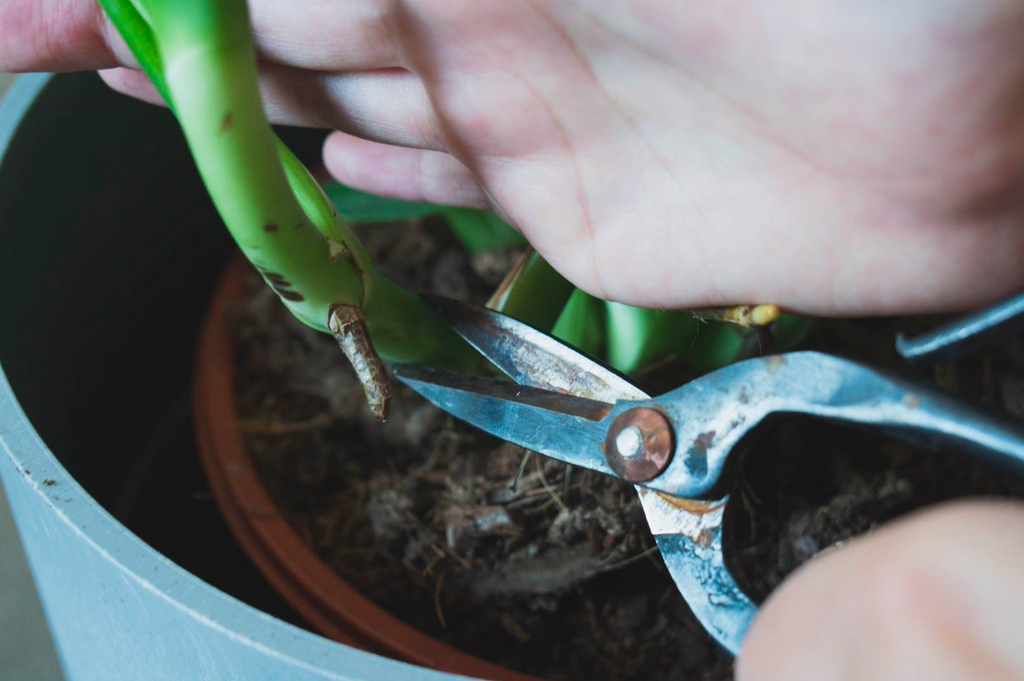Pruning is a great way to keep your houseplants looking their best. If you find your houseplants looking a bit overgrown or untidy, it might be time to prune.
When leaves naturally reach the end of their life cycle (yes, leaves only live for a limited amount of time), they will usually start to turn yellow or wilt. Pruning will stop your plant from wasting energy on the dead leaf. Plus, pruning the dead weight will help encourage new growth.
The good news is, if you have a overgrown houseplants such as the
Dumb Cane - Dieffenbachia (Conrad)
Pothos - Epipremnum Aureum (Eddie) or Swiss Cheese Plant -
Monstera Delicious (Monty) you can use the cuttings to make an entire new plant for free! Most plants can be easily propagated and the results can look incredible.
PRUNING
Pruning brown/yellow tips:

If you notice that the tips of your houseplant are turning yellow or brown, this is usually down to overwatering or lack of misting.
On this occasion, you don’t need to get rid of the entire leaf. The majority of the foliage is still perfectly healthy. Use your shears to snip off the yellow tips of the plant. This will not harm the plant.
Pruning dead, yellow or limp leaves:

These are the leaves that aren’t making a comeback anytime soon. They will probably end up going straight in the bin! These leaves can not be used for propagating.
Grab some sharp scissors or garden shears. Locate the leaf you want to prune and follow the leaf all the way back to the stem. Make a 90 degree cut at the base of the stem which will remove the entire leaf.
Removing dead flowers:
If you own houseplants that flower, you will notice that after a while the bud will turn brown or wilt. This is very common in
Peace Lilies (Spathiphyllum) and is perfectly normal.
This is part of their growth cycle. The plant does this to make room for new growth.
To remove the dead flower, you do not need to remove the entire stem. Simply cut at the base of the flower and leave the stem behind. Over time it will re-flower.
Pruning for propagating:
When you start to prune, you must look for healthy foliage. The soon-to-be new plant is most likely to thrive after it has been cut. Look for long or overgrown pieces of foliage. In my propagating section below I'll explain where you cut your foliage for the best results.
Even if you aren’t planning to propagate, your houseplant will still benefit from overgrowth pruning.
3 Things to avoid when pruning:
1. Try to only prune when needed. Over pruning can lead to growing problems later on.
2. If possible, try to avoid cutting a leaf that is in the process of birthing a new leaf. These stems are best left alone during the growing process.
3. Use scissors to remove dead leaves rather than pulling them off with your hands. Pulling them off may damage the healthy foliage around the dead leaf.

PROPAGATING
Propagating made easy
Propagating is the process of taking cuttings from your plants, then using them to make brand new plants. It’s free and less work than you think. The very first time I propagated I was very nervous. I learned it was much simpler than I had originally thought and the results were very rewarding.
There are two main ways to propagate your plants. The method used may vary depending on which plant you want to propagate.
Propagating straight into soil:
This is a very simple method. If you notice your plant sprouting a baby you should wait until they are about 5-6 inches tall. This method is mainly used for plants that sprout babies such as our Sammy the
Snake plant (Sansevieria), Zara the
Elephant ear plant (Alocasia) and Conrad the
Dumb Cane (Dieffenbachia)
When the baby is tall enough, you can then separate it by removing the entire plant out of its nursery pot. Gently remove the section of soil around the baby and then place the offspring into a new pot. Once the baby houseplant is in its new home, add some multi-purpose soil to fill in the gaps.
It really is that simple. Give your new plant a thorough drink of water and find a new place to put it in your space.
Propagating with water:
This is the most common way to propagate your plant. The first thing you will need to do is cut a trimming from the plant you want to propagate.
This is a perfect way to keep your existing plants looking trim, as well as using those extra trimmings to make more plants.
Once you’ve found a good trimming to cut, you will want to find the ‘node’ of the plant (pictures below). This is where the roots are going to grow from once they are put in water. Cut about 1-2 cm away from the node (on the side closer to the soil).

Once you have cut the trimmings, place them in a glass vase. Leave in water for a couple of weeks and you should start to see the roots begin to appear. Replace the water every week to keep it fresh.
The amount of time this process takes varies on each particular plant. Once the roots can clearly be seen, you can move onto potting the trimmings into soil.
This step is really simple. Remove the trimming from water and place the roots into a pot. Remember to make sure the pot has proper drainage. There should be a tightly compact, thin layer of soil at the bottom of the pot.
Place the trimming into the pot. When you go to cover the roots with soil, make sure it is moist. This is going to help your plant transition from only being in water, to a regular pot with soil.
Once the trimming has been re-potted, you can give the soil a nice water and find a good spot for your new plant.
Right now is a perfect time to prune your houseplants in preparation for Winter. The best time to propagate your plant is usually later winter or spring. Simple upkeep is going to keep your houseplants looking fresh. With this new information, you can feel prepared and reassured that your plants are in good hands.













Thank you
Thank you, very helpful 🙏🏻
Leave a comment